Brazilian real
The Brazilian real (/reɪˈɑːl/; Portuguese: real, pl. reais; sign: R$; code: BRL) is the official currency of Brazil. It is subdivided into 100 centavos. The Central Bank of Brazil is the central bank and the issuing authority. The real replaced the Brazilian cruzeiro.
| Brazilian real | |||||
|---|---|---|---|---|---|
| real brasileiro (Portuguese) | |||||
| |||||
| ISO 4217 | |||||
| Code | BRL | ||||
| Number | 986 | ||||
| Exponent | 2 | ||||
| Denominations | |||||
| Subunit | |||||
| 1/100 | centavo | ||||
| Plural | Reais | ||||
| Symbol | R$ | ||||
| Banknotes | |||||
| Freq. used | R$2, R$5, R$10, R$20, R$50, R$100 | ||||
| Rarely used | R$1 | ||||
| Coins | |||||
| Freq. used | 5, 10, 25, 50 centavos, and R$1 | ||||
| Rarely used | 1 centavo | ||||
| Demographics | |||||
| User(s) | |||||
| Issuance | |||||
| Central bank | Central Bank of Brazil | ||||
| Website | www | ||||
| Printer | Casa da Moeda do Brasil | ||||
| Website | www | ||||
| Mint | Casa da Moeda do Brasil | ||||
| Website | www | ||||
| Valuation | |||||
| Inflation | 3.75% (2018)[1] | ||||
| Source | Central Bank of Brazil, 2018 | ||||
| Method | CPI | ||||
As of April 2016, the real is the nineteenth most traded currency in the world by value.[2]
History
The modern real (Portuguese plural reais or English plural reals) was introduced on 1 July 1994, during the presidency of Itamar Franco, when Rubens Ricupero was the Minister of 'Fazenda'—Brazilian nomenclature for Minister of Finance—as part of a broader plan to stabilize the Brazilian economy, known as the Plano Real. The new currency replaced the short-lived cruzeiro real (CR$). The reform included the demonetisation of the cruzeiro real and required a massive banknote replacement.
At its introduction, the real was defined to be equal to 1 unidade real de valor (URV, "real value unit") a non-circulating currency unit. At the same time the URV was defined to be worth 2,750 cruzeiros reais, which was the average exchange rate of the U.S. dollar to the cruzeiro real on that day. As a consequence, the real was worth exactly one U.S. dollar as it was introduced. Combined with all previous currency changes in the country's history, this reform made the new real equal to 2.75 × 1018 (2.75 quintillion) of Brazil's original réis.
Soon after its introduction, the real unexpectedly gained value against the U.S. dollar, due to large capital inflows in late 1994 and 1995. During that period it attained its maximum dollar value ever, about US$1.20. Between 1996 and 1998 the exchange rate was tightly controlled by the Central Bank of Brazil, so that the real depreciated slowly and smoothly in relation to the dollar, dropping from near 1:1 to about 1.2:1 by the end of 1998. In January 1999 the deterioration of the international markets, disrupted by the Russian default, forced the Central Bank, under its new president Arminio Fraga, to float the exchange rate. This decision produced a major devaluation, to a rate of almost R$2:US$1.[3]
In the following years, the currency's value against the dollar followed an erratic but mostly downwards path from 1999 until late 2002, when the prospect of the election of leftist candidate Luiz Inácio Lula da Silva, considered a radical populist by sectors of the financial markets, prompted another currency crisis and a spike in inflation. Many Brazilians feared another default on government debts or a resumption of heterodox economic policies, and rushed to exchange their reais into tangible assets or foreign currencies.
The crisis subsided once Lula took office, after he, his finance minister Antonio Palocci, and Arminio Fraga reaffirmed their intention to continue the orthodox macroeconomic policies of his predecessor (including inflation-targeting, primary fiscal surplus and floating exchange rate, as well as continued payments of the public debt). The value of the real in dollars continued to fluctuate but generally upwards, so that by 2005 the exchange was a little over R$2:US$1. In May 2007, for the first time since 2001(last 6 years), the real became worth more than US$0.50—even though the Central Bank, concerned about its effect on the Brazilian economy, had tried to keep it below that symbolic threshold.
The exchange rate as of September 2015 was BRL 4.05 to US$1.00, however it has since been in a gradual recovery period, reaching 3.0 BRL per US dollar by February 2017.
Coins
First series (1994–1997)
Along with the first series of currency, coins were introduced in denominations of 1, 5, 10 and 50 centavos and 1 real; the 25 centavos piece was soon followed. All were struck in stainless steel. The original 1-real coins(produced only in 1994) were demonetized on 23 December 2003;[4] all other coins remain legal tender.
| First series | ||
|---|---|---|
| Image | Value | Design |
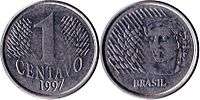 |
1 centavo | Obverse: Large denomination flanked by linear patterns. Reverse: Head of Republic. |
 |
5 centavos | Obverse: Large denomination flanked by linear patterns. Reverse: Head of Republic. |
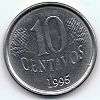 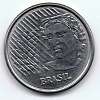 |
10 centavos | Obverse: Large denomination flanked by linear patterns. Reverse: Head of Republic. |
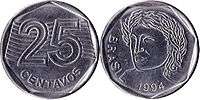 |
25 centavos | Obverse: Large denomination intersected by wavy lines. Reverse: Head of Republic. |
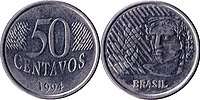 |
50 centavos | Obverse: Large denomination flanked by linear patterns. Reverse: Head of Republic. |
 |
1 real (withdrawn from circulation) |
Obverse: Large denomination flanked by linear patterns. Reverse: Head of Republic. |
Second series (1998–present)
In 1998, a second series of coins was introduced. It featured copper-plated steel coins of 1 and 5 centavos, brass-plated steel coins of 10 and 25 centavos, a cupronickel 50 centavos coin, and a bi-coloured brass and cupronickel coin of 1 real. However, from 2002 onwards, steel was used for the 50 centavos coin and the central part of the 1 real coin.
In November 2005, the Central Bank discontinued the production of the 1 centavo coins, but the existing ones continue to be legal tender. Retailers now generally round their prices to the next 5 or 10 centavos.
| Second series | ||
|---|---|---|
| Image | Value | Design |
 |
1 centavo (no longer produced) |
Obverse: The Southern Cross in right upper side. Reverse: Depicts Pedro Álvares Cabral, Portuguese sea captain and Brazil's discoverer, with a 16th-century Portuguese ship in the background. |
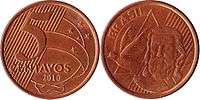 |
5 centavos | Obverse: The Southern Cross in right upper side. Reverse: Depicts Joaquim José da Silva Xavier (also known as Tiradentes), martyr of an early independence movement known as the Minas Conspiracy. In the background, a triangle, symbol of the movement, and a dove, symbol of peace and freedom. |
 |
10 centavos | Obverse: The Southern Cross in right upper side. Reverse: Depicts Emperor Pedro I, Brazil's first monarch. In the background, the Emperor on a horse: a scene alluding to the proclamation of independence. |
 |
25 centavos | Obverse: The Southern Cross in right upper side. Reverse: Depicts Field Marshal Deodoro da Fonseca, Brazil's first Republican president. The Republic's coat of arms is in the background. |
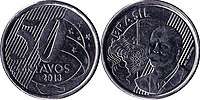 |
50 centavos | Obverse: The Southern Cross in right upper side. Reverse: Depicts José Paranhos, Jr., the Baron of Rio Branco, the country's most distinguished Minister of Foreign Affairs. In the background, image of the country with ripples expanding outwards, representing the development of Brazil's foreign policy and the expansion and demarcation of the national borders. |
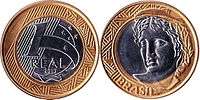 |
1 real | Obverse: The Southern Cross in right upper side. Reverse: Outer ring depicts a sample of the marajoara art pattern. In the inner ring, the Efígie da República, symbol of the Republic. |
Commemorative coins
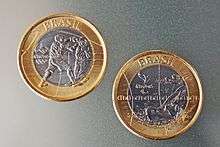
The Brazilian Central Bank has also issued special commemorative versions of some coins on special occasions. These coins are legal tender and differ from the standard ones only on their reverse side.
| Image | Value | Details |
|---|---|---|
 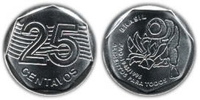 |
10 and 25 centavos | Release date: 31 May 1995 Occasion: The 50th anniversary of the Food and Agriculture Organization (FAO) Units produced: 1 million for each design Reverse: The 10 centavos coin depicts hands offering a plant shoot with folious ramifications, and the 25 centavos coin depicts crop cultivation. Both coins contain the inscriptions "FAO—1945/1995" and "alimentos para todos" (food for all).[5][6] |
 |
1 real | Release date: 10 December 1998 Occasion: The 50th anniversary of the Universal Declaration of Human Rights Units produced: 600 thousand Reverse: The official logo of the commemorations; in bas-relief, a human figure. In the outer ring, the inscriptions "Declaração Universal dos Direitos Humanos" (Universal Declaration of Human Rights) and "Cinqüentenário" (50th anniversary).[7] |
 |
1 real | Release date: 12 September 2002 Occasion: The 100th birth anniversary of Brazilian former president Juscelino Kubitschek Units produced: 50 million Reverse: A face portrait of Kubitschek. Vertically, the inscription "Centenário Juscelino Kubitschek" (Juscelino Kubitschek's centenary). In the outer ring, images alluding to the columns of the Alvorada Palace, the Presidential residence in Brasília, the city that he decided would be built.[8] |
 |
1 real | Release date: 23 September 2005 Occasion: The 40th anniversary of the foundation of the Central Bank of Brazil Units produced: 40 million Reverse: Image of the trademark Central Bank building, inspired in the official logo developed for the commemorations. In the outer ring, the inscriptions "Banco Central do Brasil" (Central Bank of Brazil) and "1965 40 anos 2005" (1965 40 years 2005).[9] |
 |
1 real | Release date: 13 August 2012 Occasion: The Olympic Flag Handover for the Rio 2016 Summer Olympics Units produced: 2 million Reverse: The Olympic Flag in a pole above the official logo of the Games of the XXXI Olympiad. In the outer ring, the inscriptions "Entrega da Bandeira Olímpica" (Olympic Flag Handover) and "Londres 2012—Rio 2016" (London 2012—Rio 2016)[10] |
.png) .png) .png) .png) .png) .png) .png) .png) .png) .png) .png) .png) .png) .png) .png) .png) |
1 real | Release dates: 28 November 2014, 17 April 2015, 7 August 2015, 19 February 2016 (four sets of four designs) Occasion: 2016 Summer Olympics Units produced: 20 million for each design Reverse: Sixteen coin designs, representing athletics (triple jump), swimming, paralympic triathlon, golf, basketball, sailing, paralympic canoeing, rugby, football, volleyball, paralympic athletics (running), judo, boxing, paralympic swimming, and each mascot of the 2016 Summer Olympics and Paralympics.[10] |
.png) |
1 real | Release date: 30 March 2015 Occasion: The 50th anniversary of the foundation of the Central Bank of Brazil Units produced: 50 million Reverse: The Central Bank building, its logo, and the inscription "50 anos" (50 years).[10] |
| 1 real | Release date: 28 August 2019 Occasion: The 25th anniversary of the creation of the Plano Real (Real Plan) Units produced: 25 million Reverse: A hummingbird feeding its chicks, based on the image of the 1 real banknote. |
Banknotes
First series (1994–2010)
In 1994, banknotes were introduced in denominations of 1, 5, 10, 50 and 100 reais. These were followed by 2 reais in 2000 and 20 reais in 2001. On 31 December 2005, BCB discontinued the production of the 1 real banknote.
| Real series[11] | ||||||
|---|---|---|---|---|---|---|
| Image | Value | Dimensions | Description | |||
| Obverse | Reverse | Obverse | Reverse | |||
 |
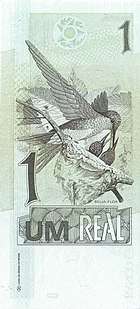 |
1 real | 140 mm × 65 mm | The Republic's Effigy, portrayed as a bust |
Sapphire-spangled emerald hummingbird (Amazilia lactea) | |
 |
 |
2 reais | Hawksbill turtle (Eretmochelys imbricata) | |||
 |
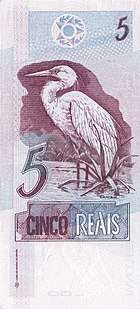 |
5 reais | Great egret (Casmerodius albus) | |||
 |
 |
10 reais | Green-winged macaw (Ara chlorepterus) | |||
 |
 |
20 reais | Golden lion tamarin (Leontopithecus rosalia) | |||
 |
 |
50 reais | Jaguar (Onça pintada, Panthera onca) | |||
 |
 |
100 reais | Dusky Grouper (Epinephelus marginatus) | |||
Second series (2010–present)
On 3 February 2010, the Central Bank of Brazil announced the new series of the real banknotes which would begin to be released in April 2010. The new design added security enhancements in an attempt to reduce counterfeiting. The notes have different sizes according to their values to help vision-impaired people. The changes were made reflecting the growth of the Brazilian economy and the need for a stronger and safer currency. The new banknotes began to enter circulation in December 2010, coexisting with the older ones.[12][13]
| 2010, 2011, and 2012 series | |||||||||
|---|---|---|---|---|---|---|---|---|---|
| Image | Value | Dimensions | Main color | Description | Date of first issue | Watermark | |||
| Obverse | Reverse | Obverse | Reverse | ||||||
 |
 |
2 reais | 121 mm × 65 mm | Blue | Wave pattern; head of Republic | Hawksbill turtle (Eretmochelys imbricata) | 29 July 2013 | Hawksbill turtle and electrotype 2 | |
 |
 |
5 reais | 128 mm x 65 mm | Purple | Plants; head of Republic | Great egret (Casmerodius albus) | 29 July 2013 | Great egret and electrotype 5 | |
 |
 |
10 reais | 135 mm × 65 mm | Red | Plants; head of Republic | Green-winged macaw (Ara chlorepterus) | 23 July 2012 | Green-winged macaw and electrotype 10 | |
 |
 |
20 reais | 142 mm × 65 mm | Yellow | Plants; head of Republic | Golden lion tamarin (Leontopithecus rosalia) | 23 July 2012 | Golden lion tamarin and electrotype 20 | |
 |
 |
50 reais | 149 mm × 70 mm | Brown | Jungle plants; head of Republic | Jaguar (Panthera onca) | 13 December 2010 | Jaguar and electrotype 50 | |
 |
 |
100 reais | 156 mm × 70 mm | Cyan | Underwater plants and starfish; head of Republic; coral | Dusky Grouper (Epinephelus marginatus); coral | 13 December 2010 | Dusky Grouper and electrotype 100 | |
Commemorative banknotes
In April 2000, in commemoration of the 500th anniversary of the Portuguese arrival on Brazilian shores, the Brazilian Central Bank released a polymer 10 real banknote that circulates along with the other banknotes above. The Brazilian Mint printed 250 million of these notes, which at the time accounted for about half of the 10 real banknotes in circulation.
| Obverse | Reverse | Value | Year | Material | Description |
|---|---|---|---|---|---|
 |
 |
10 reais | 2000 | Polymer | Obverse: Image of the Pedro Álvares Cabral, discoverer of Brazil. Reverse: Stylized version of the map of Brazil, with pictures highlighting the ethnic and cultural plurality of the country. |
Exchange rates
| Rank | Currency | ISO 4217 code (symbol) | % of daily trades (bought or sold) (April 2019) |
|---|---|---|---|
1 | USD (US$) | 88.3% | |
2 | EUR (€) | 32.3% | |
3 | JPY (¥) | 16.8% | |
4 | GBP (£) | 12.8% | |
5 | AUD (A$) | 6.8% | |
6 | CAD (C$) | 5.0% | |
7 | CHF (CHF) | 5.0% | |
8 | CNY (元) | 4.3% | |
9 | HKD (HK$) | 3.5% | |
10 | NZD (NZ$) | 2.1% | |
11 | SEK (kr) | 2.0% | |
12 | KRW (₩) | 2.0% | |
13 | SGD (S$) | 1.8% | |
14 | NOK (kr) | 1.8% | |
15 | MXN ($) | 1.7% | |
16 | INR (₹) | 1.7% | |
17 | RUB (₽) | 1.1% | |
18 | ZAR (R) | 1.1% | |
19 | TRY (₺) | 1.1% | |
20 | BRL (R$) | 1.1% | |
21 | TWD (NT$) | 0.9% | |
22 | DKK (kr) | 0.6% | |
23 | PLN (zł) | 0.6% | |
24 | THB (฿) | 0.5% | |
25 | IDR (Rp) | 0.4% | |
26 | HUF (Ft) | 0.4% | |
27 | CZK (Kč) | 0.4% | |
28 | ILS (₪) | 0.3% | |
29 | CLP (CLP$) | 0.3% | |
30 | PHP (₱) | 0.3% | |
31 | AED (د.إ) | 0.2% | |
32 | COP (COL$) | 0.2% | |
33 | SAR (﷼) | 0.2% | |
34 | MYR (RM) | 0.1% | |
35 | RON (L) | 0.1% | |
| Other | 2.2% | ||
| Total[note 1] | 200.0% | ||
Historical exchange rate
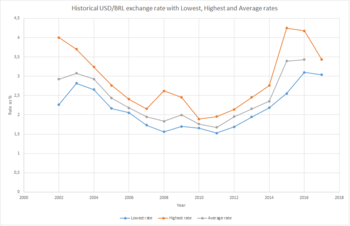

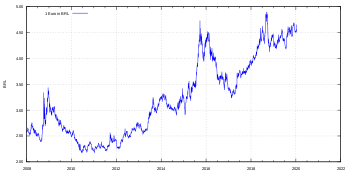
| Year | Lowest ↓ | Highest ↑ | Average | |||||
|---|---|---|---|---|---|---|---|---|
| Date | Rate | Date | Rate | Rate | ||||
| 2002 | 11 April | 2.264 | 10 October | 4.005 | 2.9221 | |||
| 2003 | 2 July | 2.818 | 14 February | 3.700 | 3.078 | |||
| 2004 | 30 December | 2.654 | 22 May | 3.242 | 2.926 | |||
| 2005 | 11 November | 2.163 | 15 March | 2.766 | 2.4349 | |||
| 2006 | 5 May | 2.056 | 24 May | 2.405 | 2.1782 | |||
| 2007 | 14 November | 1.732 | 5 January | 2.153 | 1.948 | |||
| 2008 | 31 July | 1.562 | 5 December | 2.621 | 1.8349 | |||
| 2009 | 15 October | 1.698 | 2 March | 2.451 | 1.9974 | |||
| 2010 | 13 October | 1.655 | 5 February | 1.891 | 1.7603 | |||
| 2011 | 26 July | 1.5284 | 22 September | 1.952 | 1.675 | |||
| 2012 | 29 February | 1.692 | 3 December | 2.1395 | 1.9546 | |||
| 2013 | 11 March | 1.943 | 21 August | 2.4523 | 2.1576 | |||
| 2014 | 10 April | 2.1825 | 16 December | 2.7614 | 2.3531 | |||
| 2015 | 22 January | 2.5554 | 23 September | 4.2491 | 3.391 | |||
| 2016 | 25 October | 3.1023 | 22 January | 4.1737 | 3.430 | |||
| 2017 | 16 February | 3.0390 | 18 May | 3.4300 | ||||
| Date | Rate |
|---|---|
| 1994-07-01 | 1.00 |
| 1994-10-14 | 0.83 |
| 1995-02-15 | 0.88 |
| 1995-12-29 | 0.97 |
| 1996-06-11 | 1.00 |
| 1996-12-31 | 1.04 |
| 1997-12-31 | 1.12 |
| 1998-12-31 | 1.20 |
| 1999-01-12 | 1.21 |
| 1999-01-13 | 1.31 |
| 1999-01-29 | 1.98 |
| 1999-03-03 | 2.16 |
| 1999-04-30 | 1.66 |
| 1999-12-31 | 1.78 |
| 2000-12-31 | 1.96 |
| 2001-05-02 | 2.23 |
| 2001-10-15 | 2.78 |
| 2002-01-25 | 2.38 |
| 2002-04-12 | 2.27 |
| 2002-06-27 | 2.83 |
| 2002-09-30 | 3.87 |
| 2002-10-12 | 3.93 |
| 2002-10-22 | 3.96 |
| 2002-12-27 | 3.53 |
| 2003-02-18 | 3.61 |
| 2003-06-28 | 2.87 |
| 2003-09-30 | 2.93 |
| 2003-12-28 | 2.93 |
| 2004-03-31 | 2.91 |
| 2004-05-23 | 3.18 |
| 2004-06-28 | 3.10 |
| 2004-09-30 | 2.85 |
| 2004-12-28 | 2.69 |
| 2005-02-19 | 2.56 |
| 2005-03-26 | 2.73 |
| 2005-06-28 | 2.38 |
| 2005-09-25 | 2.26 |
| 2005-11-11 | 2.17 |
| 2005-12-28 | 2.36 |
| 2006-03-27 | 2.15 |
| 2006-05-07 | 2.05 |
| 2006-12-29 | 2.13 |
| 2007-11-07 | 1.73 |
| 2008-08-01 | 1.56 |
| 2009-03-03 | 2.42 |
| 2009-10-14 | 1.71 |
| 2010-12-30 | 1.66 |
| 2011-07-23 | 1.53 |
| 2012-03-18 | 1.79 |
| 2012-08-19 | 2.01 |
| 2013-03-31 | 2.01 |
| 2013-07-13 | 2.26 |
| 2013-11-01 | 2.23 |
| 2014-01-23 | 2.40 |
| 2014-02-06 | 2.40 |
| 2014-10-23 | 2.50 |
| 2014-12-16 | 2.75 |
| 2015-01-22 | 2.56 |
| 2015-02-02 | 2.71 |
| 2015-03-06 | 3.05 |
| 2015-03-19 | 3.29 |
| 2015-04-24 | 2.95 |
| 2015-04-28 | 2.88 |
| 2015-05-08 | 2.97 |
| 2015-05-29 | 3.18 |
| 2015-08-06 | 3.53 |
| 2015-09-01 | 3.69 |
| 2015-09-04 | 3.80 |
| 2015-09-17 | 3.88 |
| 2015-09-22 | 4.05 |
| 2015-09-24 | 4.24 |
| 2015-09-25 | 3.97 |
| 2015-10-02 | 3.94 |
| 2015-10-09 | 3.75 |
| 2015-11-20 | 3.69 |
| 2015-12-03 | 3.74 |
| 2015-12-09 | 3.73 |
| 2016-02-23 | 3.97 |
| 2016-03-13 | 3.58 |
| 2016-06-30 | 3.18 |
| 2016-10-25 | 3.10 |
| 2017-02-14 | 3.09 |
Current exchange rates
| Current BRL exchange rates | |
|---|---|
| From Google Finance: | AUD CAD CHF EUR GBP HKD JPY USD INR RUB ARS |
| From Yahoo! Finance: | AUD CAD CHF EUR GBP HKD JPY USD INR RUB ARS |
| From XE.com: | AUD CAD CHF EUR GBP HKD JPY USD INR RUB ARS |
| From OANDA: | AUD CAD CHF EUR GBP HKD JPY USD INR RUB ARS |
| From fxtop.com: | AUD CAD CHF EUR GBP HKD JPY USD INR RUB ARS |
See also
- Central Bank of Brazil
- Economy of Brazil
- Plano Real
- Portuguese real
Notes
- The total sum is 200% because each currency trade always involves a currency pair; one currency is sold (e.g. US$) and another bought (€). Therefore each trade is counted twice, once under the sold currency ($) and once under the bought currency (€). The percentages above are the percent of trades involving that currency regardless of whether it is bought or sold, e.g. the U.S. Dollar is bought or sold in 88% of all trades, whereas the Euro is bought or sold 32% of the time.
References
- "Inflação oficial fecha 2018 em 3,75%". Central Bank of Brazil. 11 January 2019. Retrieved 11 January 2019.
- "Triennial Central Bank Survey Foreign exchange turnover in April 2016" (PDF). Triennial Central Bank Survey. Basel, Switzerland: Bank for International Settlements. 11 December 2016. p. 7. Retrieved 22 March 2017.
- BNDES: BRAZIL IN THE 1990: A SUCCESSFUL TRANSITION? page 10.
- 1 Real stainless steel coin exchange, Central Bank of Brazil.
- Circulating commemorative coin of the FAO 50th anniversary, 10 cents, Central Bank of Brazil.
- Circulating commemorative coin of the FAO 50th anniversary, 25 cents, Central Bank of Brazil.
- Circulating commemorative coin of the Universal Declaration of Human Rights 50th anniversary, Central Bank of Brazil.
- Circulating commemorative coin of Juscelino Kubitschek de Oliveira 100th anniversary, Central Bank of Brazil.
- Circulating commemorative coin of the 40th anniversary of the Banco Central do Brasil, Central Bank of Brazil.
- Real coins—commemorative, Central Bank of Brazil (in Portuguese).
- http://www.bc.gov.br/?CEDCOMUM
- Cucolo, Eduardo (13 December 2010). "Novas cédulas do real devem chegar a todas as capitais em até 48 horas" [New Real banknotes should arrive within 48 hours in all capitals]. Folha de S.Paulo (in Portuguese). Retrieved 14 December 2010.
- Brazil introduces new 10- and 20-real banknotes on 23 July 2012 BanknoteNews.com. Retrieved 2012-07-24.
- "Triennial Central Bank Survey Foreign exchange turnover in April 2019" (PDF). Bank for International Settlements. 16 September 2019. p. 10. Retrieved 16 September 2019.
External links
| Wikimedia Commons has media related to Brazilian real. |